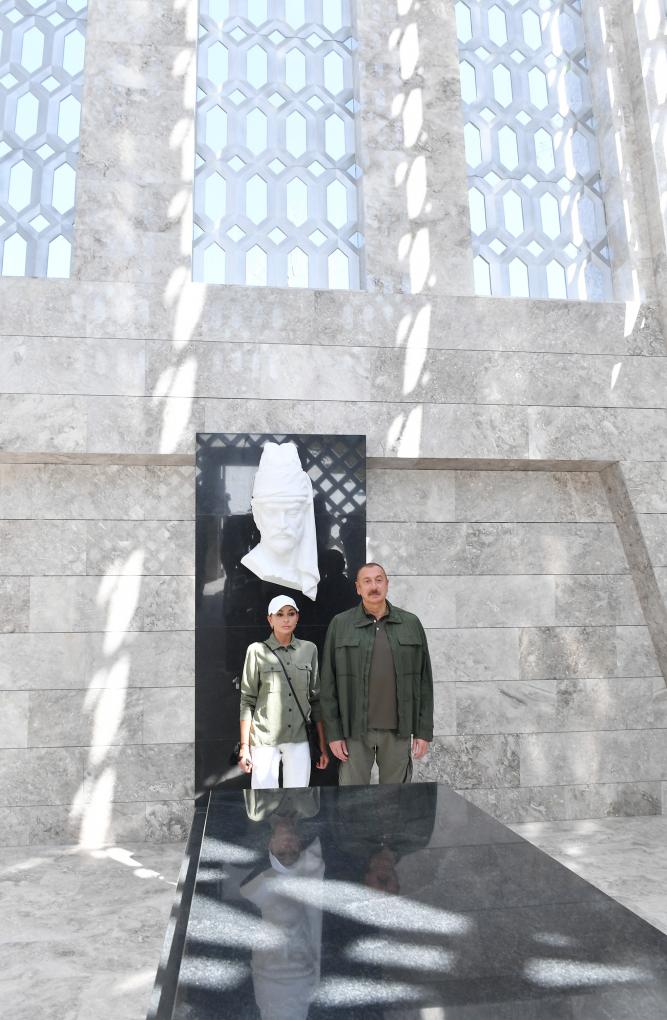SHUSHA
29
AUGUST2021
Inauguration of the Museum-Mausoleum Complex of Molla Panah Vagif
After the restoration and reconstruction works, the inauguration of the museum-mausoleum complex genius Azerbaijani poet and public figure Molla Panah Vagif took place in Shusha. On August 29, President of the Republic of Azerbaijan Ilham Aliyev and First Lady Mehriban Aliyeva attended the inauguration ceremony and became familiar with the carried-out works.
The inauguration of the grandiose mausoleum erected over the grave of Molla Panah Vagif in the city of Shusha, the cultural capital of Azerbaijan, took place on January 14, 1982, with the initiative and participation of Azerbaijani people’s National Leader Heydar Aliyev. It was within the framework of this trip that the National Leader Heydar Aliyev gave instructions to hold the Vagif’s Poetry Days, and from July 29 to August 3 of that year, this event was held for the first time in Shusha.
The museum-mausoleum complex had been constructed over the grave of the genius poet in an area close to the Jidir Duzu. While deciding to construct the four-cornered mausoleum decorated with marble, the compositional structure of the tower-shaped mausoleums of Azerbaijan was used, considering the surrounding landscape and town-building features. Local traditions of popular architecture, monumental and decorative, and applied plastic were used to construct the mausoleum. A bust of Molla Panah Vagif, made by sculptor Albert Mustafayev, was installed inside the mausoleum. As a result of the occupation of Shusha in 1992 by Armenia, the building of the complex and all exhibitions in the complex were destroyed. After the liberation of Shusha, restoration and reconstruction works were launched here, based on the instruction of President of the Republic of Azerbaijan Ilham Aliyev given during his visit to Shusha on January 14th – on the same day as the inauguration of the mausoleum 39 years earlier – at the time of visiting the mausoleum.
The restoration and reconstruction works on the mausoleum were carried out by the Heydar Aliyev Foundation. Starting from March 2021, the mausoleum was subjected to structural examination in the primary stage, and reinforcement works were carried out on the required parts and working designs developed within this framework. Based on the working designs, structural restoration of the parts was carried out using the chemical materials recommended by foreign specialists, taking additional measures against corrosion. Using the data obtained as a result of topographical works, together with acquiring broken and destroyed facing materials by carrying out search works on the territory, architectural working designs were developed to restore the monument’s preliminary dimensions. Based on these designs, the walls of the interior parts and the façade were covered with marble, returning the monument’s historical appearance.
Moreover, all ornaments and decorative patterns, including the entry door, were made of aluminum by casting method – based on the working designs developed on the basis of cast aluminum ornament samples found on the territory, keeping the original dimensions – and were installed according to the design, after they were brought to Shusha city. A tombstone made of black marble was placed over the grave in the center of the salon, and a bust was prepared of white marble, considering the preliminary form’s restoration. The historical form was maintained in every detail of the monument. All the infrastructure of the monumental complex was rebuilt, and rainwater gutters and electricity lines were built. The supporting walls and the square on the landscape were covered with granite keeping their historical appearance. At the same time, rose bushes of different types – as depicted in pictures of that time – were planted.

